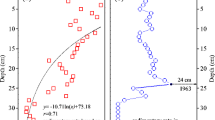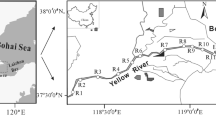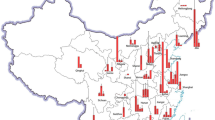Abstract
Twenty-nine sediment samples were collected from Lake Chaohu, a shallow eutrophic lake in Eastern China, and were analyzed for 15 priority polycyclic aromatic hydrocarbons (PAHs) to determine the spatial distribution and exposure risks of PAHs. Three receptor models, the principal component analysis-multiple linear regression (PCA-MLR) model, the positive matrix factorization (PMF) model, and the Unmix model, were used in combination with the PAHs diagnostic ratios to investigate the potential source apportionment of PAHs. A clear gradient in the spatial distribution and the potential toxicity of PAHs was observed from west to east in the sediments of Lake Chaohu. ∑15PAH concentrations and the TEQ were in the range of 80.82-30 365.01 ng g−1 d.w. and 40.77-614.03, respectively. The highest values of the aforementioned variables were attributed to urban–industrial pollution sources in the west lake region, and the levels decreased away from the river inlets. The three different models yielded excellent correlation coefficients between the predicted and measured levels of the 15 PAH compounds. Similarly, source apportionment results were derived from the three receptor models and the PAH diagnostic ratios, suggesting that the highest contribution to the PAHs was from coal combustion and wood combustion, followed by vehicular emissions. The PMF model yielded the following contributions to the PAHs from gasoline combustion, diesel combustion, unburned petroleum emissions, and wood combustion: 34.49, 24.61, 16.11, 13.01, and 11.78 %, respectively. The PMF model produced more detailed source apportionment results for the PAHs than the PCA-MLR and Unmix models.




Similar content being viewed by others
References
Agarwal T, Khillare PS, Shridhar V (2006) PAHs contamination in bank sediment of the Yamuna River, Delhi, India. Environ Monit Assess 123(1–3):151–166
Ahrens MJ, Depree CV (2010) A source mixing model to apportion PAHs from coal tar and asphalt binders in street pavements and urban aquatic sediments. Chemosphere 81(11):1526–1535
Bakhtiari AR, Zakaria MP, Yaziz MI, Lajis MNH, Bi X, Rahim MCA (2009) Vertical distribution and source identification of polycyclic aromatic hydrocarbons in anoxic sediment cores of Chini Lake, Malaysia: perylene as indicator of land plant-derived hydrocarbons. Appl Geochem 24(9):1777–1787
Barakat A, Mostafa A, Wade T, Sweet S, Sayed N (2011) Spatial distribution and temporal trends of polycyclic aromatic hydrocarbons (PAHs) in sediments from Lake Maryut, Alexandria, Egypt. Water Air Soil Pollut 218(1–4):63–80
CCME (Canadian Council of Ministers of the Environment) (2010) Polycyclic aromatic hydrocarbons. Canadian soil quality guidelines for protection of environmental and human health. Canadian soil quality guidelines. http://ceqg-rcqe.ccme.ca/
Chen Y, Sheng G, Bi X, Feng Y, Mai B, Fu J (2005) Emission factors for carbonaceous particles and polycyclic aromatic hydrocarbons from residential coal combustion in China. Environ Sci Technol 39(6):1861–1867
Chen HY, Teng YG, Wang JS (2012) Source apportionment of polycyclic aromatic hydrocarbons (PAHs) in surface sediments of the Rizhao coastal area (China) using diagnostic ratios and factor analysis with nonnegative constraints. Sci Total Environ 414:293–300
Choudhary P, Routh J (2010) Distribution of polycyclic aromatic hydrocarbons in Kumaun Himalayan Lakes, northwest India. Org Geochem 41(9):891–894
Guo J, Wu F, Luo X, Liang Z, Liao H, Zhang R, Li W, Zhao X, Chen S, Mai B (2010) Anthropogenic input of polycyclic aromatic hydrocarbons into five lakes in Western China. Environ Pollut 158(6):2175–2180
Haritash AK, Kaushik CP (2009) Biodegradation aspects of polycyclic aromatic hydrocarbons (PAHs): a review. J Hazard Mater 169(1–3):1–15
Henry RC, Christensen ER (2010) Selecting an appropriate multivariate source apportionment model result. Environ Sci Technol 44(7):2474–2481
Hu G, Luo X, Li F, Dai J, Guo J, Chen S, Hong C, Mai B, Xu M (2010) Organochlorine compounds and polycyclic aromatic hydrocarbons in surface sediment from Baiyangdian Lake, North China: concentrations, sources profiles and potential risk. J Environ Sci 22(2):176–183
Itoh N, Tamamura S, Kumagai M (2010) Distributions of polycyclic aromatic hydrocarbons in a sediment core from the north basin of Lake Biwa, Japan. Org Geochem 41(8):845–852
Jiao L, Zheng GJ, Minh TB, Richardson B, Chen L, Zhang Y, Yeung LW, Lam JC, Yang X, Lam PK, Wong MH (2009) Persistent toxic substances in remote lake and coastal sediments from Svalbard, Norwegian Arctic: levels, sources and fluxes. Environ Pollut 157(4):1342–1351
Khairy MA, Lohmann R (2012) Field validation of polyethylene passive air samplers for parent and alkylated PAHs in Alexandria, Egypt. Environ Sci Technol 46(7):3990–3998
Khairy MA, Lohmann R (2013) Source apportionment and risk assessment of polycyclic aromatic hydrocarbons in the atmospheric environment of Alexandria, Egypt. Chemosphere 91(7):895–903
Khalili NR, Scheff PA, Holsen TM (1995) PAH source fingerprints for coke ovens, diesel and, gasoline engines, highway tunnels, and wood combustion emissions. Atmos Environ 29(4):533–542
Khim JS, Kannan K, Villeneuve DL, Koh CH, Giesy JP (1999) Characterization and distribution of trace organic contaminants in sediment from Masan Bay, Korea. 1. Instrumental analysis. Environ Sci Technol 33(23):4199–4205
Lang YH, Yang W (2014) Source apportionment of PAHs using Unmix Model for Yantai costal surface sediments, China. Bull Environ Contam Toxicol 92(1):30–35
Larsen RK, Baker JE (2003) Source apportionment of polycyclic aromatic hydrocarbons in the urban atmosphere: a comparison of three methods. Environ Sci Technol 37(9):1873–1881
Li HL, Gao H, Zhu C, Li GG, Yang F, Gong ZY, Lian J (2009) Spatial and temporal distribution of polycyclic aromatic hydrocarbons (PAHs) in sediments of the Nansi Lake, China. Environ Monit Assess 154(1–4):469–478
Liu E, Shen J, Yang X, Zhang E (2012) Spatial distribution and human contamination quantification of trace metals and phosphorus in the sediments of Chaohu Lake, a eutrophic shallow lake, China. Environ Monit Assess 184(4):2105–2118
Liu Y, Beckingham B, Ruegner H, Li Z, Ma LM, Schwientek M, Xie H, Zhao JF, Grathwohl P (2013) Comparison of sedimentary PAHs in the Rivers of Ammer (Germany) and Liangtan (China): differences between early- and newly-industrialized countries. Environ Sci Technol 47:701–709
Malik A, Verma P, Singh AK, Singh KP (2011) Distribution of polycyclic aromatic hydrocarbons in water and bed sediments of the Gomti River, India. Environ Monit Assess 172(1–4):529–545
Manariotis ID, Karapanagioti HK, Chrysikopoulos CV (2011) Degradation of PAHs by high frequency ultrasound. Water Res 45(8):2587–2594
Pancras JP, Vedantham R, Landis MS, Norris GA, Ondov JM (2011) Application of EPA Unmix and nonparametric wind regression on high time resolution trace elements and speciated mercury in Tampa, Florida aerosol. Environ Sci Technol 45(8):3511–3518
Robinson AL, Subramanian R, Donahue NM, Rogge WF (2006) Source apportionment of molecular markers and organic aerosol 1. Polycyclic aromatic hydrocarbons and methodology for data visualization. Environ Sci Technol 40(24):7803–7810
Shi Z, Tao S, Pan B, Fan W, He XC, Zuo Q, Wu SP, Li BG, Cao J, Liu WX, Xu FL, Wang XJ, Shen WR, Wong PK (2005) Contamination of rivers in Tianjin, China by polycyclic aromatic hydrocarbons. Environ Pollut 134(1):97–111
Shi Z, Tao S, Pan B, Liu WX, Shen WR (2007) Partitioning and source diagnostics of polycyclic aromatic hydrocarbons in rivers in Tianjin, China. Environ Pollut 146(2):492–500
Shi GL, Tian YZ, Guo CS, Feng Y-C, Xu J, Zhang Y (2012) Sediment pore water partition of PAH source contributions to the Yellow River using two receptor models. J Soils Sediments 12(7):1154–1163
Smirnov A, Abrajano TA Jr, Smirnov A, Stark A (1998) Distribution and sources of polycyclic aromatic hydrocarbons in the sediments of Lake Erie, Part 1. Spatial distribution, transport, and deposition. Org Geochem 29(5–7):1813–1828
Sofowote UM, McCarry BE, Marvin CH (2008) Source apportionment of PAH in Hamilton harbour suspended sediments: comparison of two factor analysis methods. Environ Sci Technol 42(16):6007–6014
Tao S, Jiao XC, Chen SH, Liu WX, Coveney RM Jr, Zhu LZ, Luo YM (2006) Accumulation and distribution of polycyclic aromatic hydrocarbons in rice (Oryza sativa). Environ Pollut 140(3):406–415
US Environmental Protection Agency (2007) EPA Unmix 6.0 Fundamentals & User Guide. National Exposure Research Laboratory, Research Triangle Park, NC 27711
US Environmental Protection Agency (2008) EPA positive matrix factorization (PMF) 3.0 Fundamentals & User Guide. National Exposure Research Laboratory, Research Triangle Park, NC 27711
Ünlü S, Alpar B, Öztürk K, Vardar D (2010) Polycyclic aromatic hydrocarbons (PAHs) in the surficial sediments from Lake Iznik (Turkey): spatial distributions and sources. Bull Environ Contam Toxicol 85(6):573–580
Usenko S, Simonich SLM, Hageman KJ, Schrlau JE, Geiser L, Campbell DH, Appleby PG, Landers DH (2010) Sources and deposition of polycyclic aromatic hydrocarbons to Western U.S. National Parks. Environ Sci Technol 44(12):4512–4518
Vinas L, Angeles Franco M, Antonio Soriano J, Jose Gonzalez J, Pon J, Albaiges J (2010) Sources and distribution of polycyclic aromatic hydrocarbons in sediments from the Spanish northern continental shelf. Assessment of spatial and temporal trends. Environ Pollut 158(5):1551–1560
Walker TR, MacLean B, Appleton R, McMillan S, Miles M (2013) Cost-effective sediment dredge disposal options for small craft harbors in Canada. Remediat J 23(4):123–140
Wang Y, Li X, Li B, Shen Z, Feng C, Chen Y (2012) Characterization, sources, and potential risk assessment of PAHs in surface sediments from nearshore and farther shore zones of the Yangtze estuary, China. Environ Sci Pollut Res 19(9):4148–4158
Wang XT, Miao Y, Zhang Y, Li YC, Wu MH, Yu G (2013) Polycyclic aromatic hydrocarbons (PAHs) in urban soils of the megacity Shanghai: occurrence, source apportionment and potential human health risk. Sci Total Environ 447:80–89
Yunker MB (2002) PAHs in the Fraser River basin: a critical appraisal of PAH ratios as indicators of PAH source and composition. Org Geochem 33:489–515
Zan F, Huo S, Xi B, Li Q, Liao H, Zhang J (2011a) Phosphorus distribution in the sediments of a shallow eutrophic lake, Lake Chaohu, China. Environ Earth Sci 62(8):1643–1653
Zan F, Huo S, Xi B, Su J, Li X, Zhang J, Yeager KM (2011b) A 100 year sedimentary record of heavy metal pollution in a shallow eutrophic lake, Lake Chaohu, China. J Environ Monit 13(10):2788–2797
Zeng XY, Cao SX, Zhang DL, Gao ST, Yu ZQ, Li HR, Sheng GY, Fu JM (2012) Levels and distribution of synthetic musks and polycyclic aromatic hydrocarbons in sludge collected from Guangdong Province. J Environ Sci Health 47(3):389–397
Zhang K, Wang JZ, Liang B, Zeng EY (2011) Occurrence of polycyclic aromatic hydrocarbons in surface sediments of a highly urbanized river system with special reference to energy consumption patterns. Environ Pollut 159(6):1510–1515
Zhang Y, Guo CS, Xu J, Tian YZ, Shi GL, Feng YC (2012) Potential source contributions and risk assessment of PAHs in sediments from Taihu Lake, China: comparison of three receptor models. Water Res 46(9):3065–3073
Acknowledgments
This study was supported by the Mega-projects of Science Research for Water Environmental Improvement (Program No. 2012ZX07101-002) and the National Natural Science Foundation of China (No. 41303085).
Author information
Authors and Affiliations
Corresponding author
Additional information
Responsible editor: Hongwen Sun
Rights and permissions
About this article
Cite this article
Li, C., Huo, S., Yu, Z. et al. Spatial distribution, potential risk assessment, and source apportionment of polycyclic aromatic hydrocarbons (PAHs) in sediments of Lake Chaohu, China. Environ Sci Pollut Res 21, 12028–12039 (2014). https://doi.org/10.1007/s11356-014-3137-8
Received:
Accepted:
Published:
Issue Date:
DOI: https://doi.org/10.1007/s11356-014-3137-8




